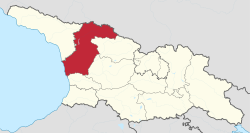
Summary
Samegrelo-Zemo Svaneti (Georgian: სამეგრელო-ზემო სვანეთი) is a region (Mkhare) in western Georgia with a population of 308,358 (2021[3]) and a surface of 7,468 km2 (2,883 sq mi).[2] The region has Zugdidi as its administrative center, while Giorgi Guguchia is governor of the region since June 2021.[5][6] Samegrelo-Zemo Svaneti is compiled of the historical Georgian provinces of Samegrelo (Mingrelia) and Zemo Svaneti (i.e., Upper Svaneti).
Samegrelo-Zemo Svaneti
სამეგრელო-ზემო სვანეთი | |
|---|---|
Mkhare (region) | |
From the top to bottom right: Enguri River, Dadiani Palace, Mestia at night, Tetnuldi, Martvili Monastery | |
 | |
| Country | |
| Capital | Zugdidi |
| Subdivisions | 1 city, 8 municipalities[1] |
| Government | |
| • Governor | Giorgi Guguchia (2 June 2021) |
| Area | |
| • Total | 7,468 km2 (2,883 sq mi) |
| Population (2021) | |
| • Total | 308,358[3] |
| Time zone | UTC+4 (Georgian Time) |
| ISO 3166 code | GE-SZ |
| HDI (2021) | 0.765[4] high · 5th |
Subdivisions edit
The region has one self governing city (Poti) and 8 municipalities with 143 administrative communities (temi),[2] totalling to 531 populated settlements:
- Eight cities: Abasha, Khobi, Martvili, Poti, Jvari, Zugdidi, Senaki and Tsalenjikha.
- Two dabas: Mestia, Chkhorotsku
- Villages: 521
Geography edit
The Samegrelo-Zemo Svaneti Mkhare can be split into two historical regions; Svaneti and Samegrelo. In the northern part of Samegrelo lies the Egrisi Mountains. The municipalities of Chkhorotsqu, Martvili, and Tsalenjikha are located right next to the Egrisi mountain range in Northern Samegrelo. In the south lies the Kolkheti valley, which is a mostly flat region. The municipalities that lie in the valley are Zugdidi, Khobi, Senaki, Abasha, and the city of Poti. The west side of Samegrelo borders Apkhazeti right on the Enguri River and the east borders Imereti on the Tskhenistsqali River. The important Rioni River of West Georgia also passes through Samegrelo, flowing into the black sea in the city of Poti. The other region; Zemo Svaneti, is located right next to the Northern Caucasus Mountain Range. Its only municipality is Mestia. Svaneti has the tallest mountain in Georgia, Mt. Shkhara, at 5,193 meters, or 17,037 feet.
Demographic edit
| Population development of the region Samegrelo-Zemo Svaneti[7] | ||||||||||||||||||
|---|---|---|---|---|---|---|---|---|---|---|---|---|---|---|---|---|---|---|
| 1959 | 1970 | 1979 | 1989 | 2002* | 2002** | 2014 | 2021 | |||||||||||
| Abasha Municipality | 30,286 | 30,416 | 29,246 | 28,219 | 28,707 | - | 22,341 | 19,560 | ||||||||||
| Khobi Municipality | 31,280 | 37,653 | 38,092 | 38,939 | 41,240 | - | 30,548 | 27,806 | ||||||||||
| Martvili Municipality | 47,777 | 49,167 | 47,797 | 46,009 | 44,627 | - | 33,463 | 31,495 | ||||||||||
| Mestia Municipality | 16,311 | 17,801 | 17,442 | 14,776 | 14,248 | - | 9,316 | 9,447 | ||||||||||
| City of Poti | 48,117 | 45,979 | 48,508 | 50,922 | 47,149 | - | 41,465 | 41,536 | ||||||||||
| Senaki Municipality | 47,553 | 50,336 | 50,774 | 52,681 | 52,112 | - | 39,652 | 34,315 | ||||||||||
| Tsalenjikha Municipality | 29,019 | 37,813 | 39,477 | 38,643 | 40,133 | - | 26,158 | 23,296 | ||||||||||
| Chkhorotsku Municipality | 27,647 | 30,784 | 31,404 | 29,840 | 30,124 | - | 22,309 | 21,361 | ||||||||||
| Zugdidi Municipality | 96,643 | 112,241 | 120,217 | 125,444 | 167,760 | - | 105,509 | 99,542 | ||||||||||
| Samegrelo-Zemo Svaneti | 374,633 | 412,190 | 422,957 | 425,473 | 466,100 | 416,349 | 330,761 | 308,358 | ||||||||||
| * Research after 2014 census showed the 2002 census was inflated by 8-9 percent.[8] **Corrected data based on retro-projection 1994–2014 in collaboration with UN[9] | ||||||||||||||||||
Ethnic groups edit
According to the Georgian census of 2014,[2] 99.37% of the population is Georgian and 0.35% is Russian. Other ethnic groups living in the region include Ukrainians, Armenians, Abkhazians and Greeks.
Languages edit
Georgian is spoken by the entire population of the region and by the ethnic minorities like Russians and others. Mingrelian is a Kartvelian language spoken by the Mingrelians, a sub-group of Georgian people and native to Mingrelia.
Svan is also a Kartvelian language, spoken by the Svans, a sub-group of Georgian people native to Svaneti.
Religion edit
About 99% of the population identifies as Orthodox Christian. Small minorities of Armenian Christians and Roman Catholics also exist.
See also edit
References edit
- ^ "Regions and municipalities of Georgia" (in Georgian). Georgian Government. Retrieved 2022-02-04.
- ^ a b c d "Main Results of the 2014 Census (Publication)" (PDF). Census.ge, National Statistics Office of Georgia (Geostat) (in Georgian). 2016-04-28. p. 229. Retrieved 2022-02-04.
- ^ a b "Population and Demography - Population as of 1 January by regions and urban-rural settlements". Retrieved 2021-11-23.
- ^ "Sub-national HDI - Area Database - Global Data Lab". hdi.globaldatalab.org. Retrieved 2018-09-13.
- ^ "Giorgi Guguchia Appointed Governor of Samegrelo-Zemo Svaneti". Georgia Today. 2021-06-02. Retrieved 2022-02-04.
- ^ "State Representative of Samegrelo-Zemo Svaneti". Samegrelo-Zemo Svaneti website (in Georgian). 2021-06-02. Retrieved 2022-02-04.
- ^ "Divisions of Georgia". Population Statistics Eastern Europe and former USSR. Retrieved 2022-02-04.
- ^ "Population Dynamics in Georgia - An Overview Based on the 2014 General Population Census Data" (PDF). National Statistics Office of Georgia, Geostat. 2017-11-29. pp. 1–4. Retrieved 2022-02-04.
- ^ "Retro-projection of main demographic indicators for the period 1994-2014". National Statistics Office of Georgia, Geostat. 2018-05-18. pp. 3, Table 1. Retrieved 2022-02-04.
External links edit
- Official web-site Samegrelo-Zemo Svaneti
42°30′N 41°51′E / 42.5°N 41.85°E







